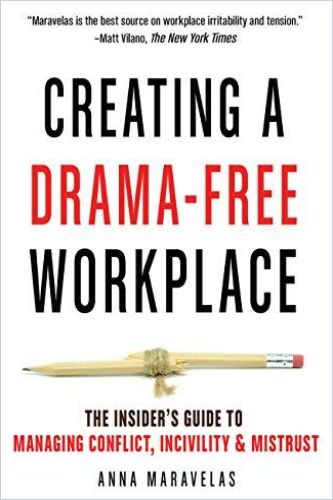“How Do I Prevent and Resolve Workplace Clashes?”

In the vast majority of cases, conflicts with other employees result from poor communication. Since communication is more than just sending around and working through to-do lists, and since we in remote teams or mixed teams do not always have all the means of conflict resolution communication at our disposal – a wink of the eye at the right moment, a pat on the back if something was not quite serious, or just a lunch together to resolve the conflict – it is important to find ways to make up for this lack.

In Creating a Drama-Free Workplace, consultant Anna Maravelas draws on her long experience to explain how to prevent and resolve workplace clashes. According to her, there are five factors that cause most workplace misunderstandings and conflicts. She illustrates these with compelling examples:
Is There a Baby in the Back Seat?
A driver stopped at a traffic light and spent most of the pause scrutinizing her back seat. When the light changed, she did not seem to notice. A man behind her honked impatiently, but the driver got out of her car and appeared to burrow in her back seat. A few minutes later she got back in the front seat and drove away. She later wrote a letter to the editor of a local newspaper. She described how the man behind her had gotten angry when she stopped. She explained that she had an infant in a car seat in the back seat, was scared the little girl had something caught in her throat and wanted to clear it. With that fear in mind she ignored the green light.
You may encounter situations at work where hidden restraints – like an unseen baby in the back seat – cause problems.
If you can discover the concealed factors driving someone’s behavior, you will learn something of great value.
Poorly Designed Systems and Processes
When systems and processes are poorly structured or instituted, they can prompt workplace clashes. Popular wisdom suggests that people’s characters don’t change, but that is incorrect. Systems and processes can have sweeping effects on behavior. For example, convicts with no possibility of obtaining parole find purpose in raising seeing-eye dogs or providing hospice care for older prisoners.
Honest people are repulsed by dishonest behavior, but some may act against their ethical principles if they feel their economic security is threatened.
Performance Measures That Conflict
Efforts to measure performance can lead to conflicts between different parts of an organization. For example, a hospital once evaluated its nursing division based on customer satisfaction while it evaluated its finance staff on the speed of the discharge process. If employees don’t discuss the inherent contradictions in such measurement processes, antagonism and factionalism can result.
Often, the way a company calculates bonuses leads to conflict. Some executives might seek to boost their individual bonuses even if doing so obstructs their ability to collaborate with other parts of the organization.

Mutual Lack of Skill, Insight or Courage
Whenever you see someone acting in a hostile, belligerent manner, consider whether the person has the ability, understanding or backbone to do better. This can save you anguish and disquiet. Use the same method to examine your own behavior.
Instead of focusing on your perceived inadequacies, ask yourself how you might approach a dilemma differently if you developed better skills, sought more in-depth comprehension or mustered more courage.
Negative Reciprocity
Mutual mistrust can leave two people at odds. A doctor worked in a hospital that provided palliative care for children. He did not approve of primary physicians continuing to treat patients who had no chance of recovery. He thought they kept persevering because they wanted to earn more money.

The primary physicians heard about his views and stopped using his services. Later, the doctor re-examined his premise. He wondered if, perhaps, primary doctors continued treating seriously ill children because they felt deeply involved and attached. Until that time, he had not recognized that he had created a negative reciprocity that – with more in-depth consideration and perception – he could help resolve.






